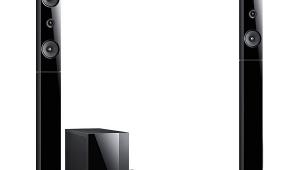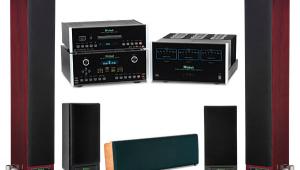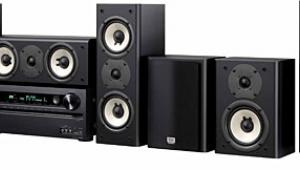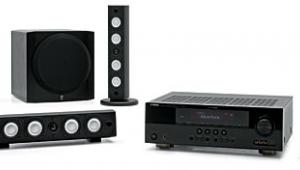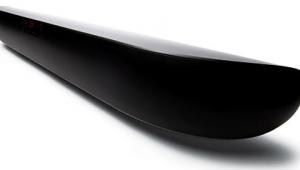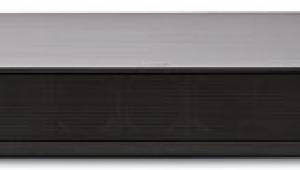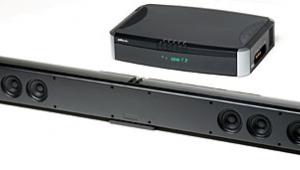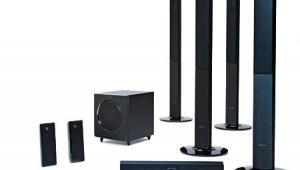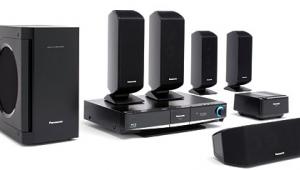Onkyo HT-S990THX Integrated Home Theater System HTIB the THX Way
by Warren Mansfield
The term home theater in a box (HTIB) causes many audiophiles to tremble. It conjures up visions of poorly designed receiver-and-speaker combos with subpar audio performance.

However, as its popularity grows, the concept of the all-in-one solution is simple to understand. It offers consumers one-stop shopping. You can buy an entire system in one fell swoop without searching around for interoperable components or studying every magazine review (no offense, HT). And HTIBs are relatively easy to assemble. You get all of the speakers and wires, often with color-coded inputs, for painless installation and setup.
So, what's the downside? By their very nature, HTIBs are designed for convenience and style. They are usually less expensive, smaller systems with restricted production budgets. Even the more expensive systems tend to focus on aesthetics rather than performance.
For years, we at THX have been asking ourselves why consumers can't have it all—a home theater system that's easy to use, easy to set up, affordable, and offers amazing performance. After all, if you've just spent your hard-earned money on a beautiful HDTV, shouldn't you be able to get a comparable HTIB system? We think so. If you agree, the new Onkyo HT-S990THX could be a match for you.
Room Size Makes a Difference
Designing the world's first THX-certified integrated home theater system was no easy task. For one thing, we wouldn't even consider lowering our performance standards. In fact, the only critical adjustment we made to the THX specifications was the performance requirements that relate to the size of the room.
THX-certification categories are based on the size of the listening environment, meaning that each THX-certified product must meet THX requirements for the room in which it is intended to be used. For instance, THX Select/Select2 products are designed for smaller home theaters, while THX Ultra/Ultra2 products are for large, dedicated home theater environments. This newest integrated–home theater specification is designed and engineered for small living areas, apartments, and dorms (less than 2,000 cubic feet in size with no more than an 8-foot viewing distance from the display to the primary seating position).
To achieve THX certification, any integrated home theater system must play at the THX reference level in its designated room size. What's a reference level? It's the audio level to which all movies are mixed in the professional studio. (Remember, THX also works with cinemas and studios.) THX-certified home theater products are designed to re-create this level in the home. If you have a properly calibrated THX-certified receiver or preamplifier, the "0" position on the volume control represents this level.
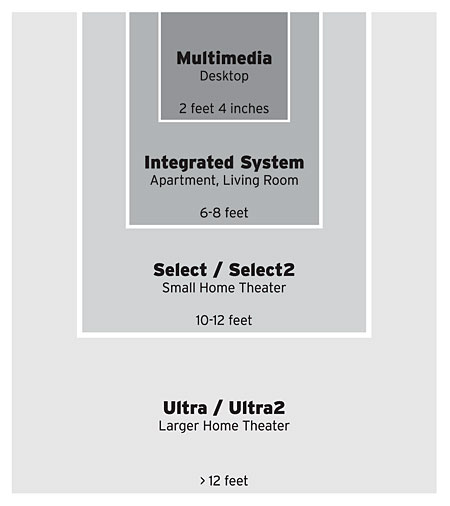
Of course, if you've ever played a movie at the THX reference level, you'll understand the challenge. It's a lot of sound, which requires a lot of power. The system itself has to have enough power and output capability to reproduce this level accurately without distorting, breaking up, or exploding while playing your favorite movie, music, or game.
In addition to room size, the size of the system itself also matters. To appeal to consumers, an integrated system needs to be fairly compact. This posed the biggest problem, because, the smaller the speaker system, the more power you need to meet THX requirements. In order to obtain the necessary power, manufacturers have to build high-output, low-distortion drivers for the speakers, especially the subwoofer. In addition to having a 20-hertz subwoofer, we require the system to meet all THX electrical parameters and features (boundary-gain compensation, setup, etc.) and to include the THX listening modes.
The Solution
Building any home theater component is a delicate balance of creative design and audio engineering. With standalone THX-certified components (receivers, power amps, speakers, etc.), we have requirements that ensure compatibility between products. This allows you to mix and match brands as long as they are certified.
An integrated system, like the Onkyo HT-S990THX, has certain advantages because all of the components are designed to work seamlessly together and are dedicated to one another. The preamp understands the power amp's capabilities, and the power amp understands the speakers. The bass-management filtering is fixed. The speakers' acoustic response is optimized with the electronics in the receiver to shrink the speaker size, increase output, lower the cost, and make the system easier to use.
We can also use built-in equalization to correct many issues with the satellite speakers. This again improves the performance while keeping costs down. As long as you carefully choose the speaker drivers, you can have your cake and eat it too—compact size, high output, low distortion, flat response, and smooth dispersion.
So, what does this mean for other THX-certified product categories? Will the HT-S990THX replace your THX Ultra2 receiver and speakers in your home theater? No—but, then again, it's not intended to. The Onkyo HT-S990THX proves that it's possible to manufacture an affordable, all-in-one home theater system that delivers outstanding performance. It took close to three years from concept to completion, with a few hurdles along the way. But, in the end, THX and Onkyo developed a truly groundbreaking home audio system, something that we are all proud of.
* Warren Mansfield is the director of consumer technology at THX Ltd. For more information, please visit www.thx.com.
